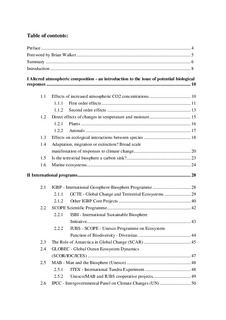| dc.description.abstract | This report presents a survey of international (Chapter 2) as well as national research activities within 13 selected countries (Chapter 3) in the field of biological effects of climate change. In addition, a brief overview of potential changes within natural ecosystems in response to climate change is given (Chapter 1). This part is intended to serve as a quick introduction for biologists who lack previous experience with the whole or parts of the field of climate change impact studies. The ultimate goal of this work is, through the information in this report, to contribute to the avoidance of unnecessary research duplication and promote scientific cooperation.
The overview in Chapter I is based on a projected doubling in atmospheric CO2 and a temperature elevation of approx. 0.3 degrees Celsius per decade over the next century. The exact magnitude of these changes is of less importance than the highly probable fact that they will occur.
At the level of individual plants, well documented responses to CO2 increase include an enhanced photosynthetic rate, a higher water use efficiency, increased relative root size, and increased tolerance to air pollutants. Elevated temperature will affect all living individuals. The immediate responses are likely to be most pronounced among plants and poikilothermic animals, because their physiological processes proceed at a rate dependent on ambient temperature. The relation between plant and animal physiology and temperature is a classical field of study, and today we benefit from the vast amount of literature which has been produced in the field. There is, however, a general lack of long-term studies.
The ultimate fate of individuals and species depends upon the responses of other organisms. Among second order effects related to elevated CO2, it is focused on interactions between herbivores and plants. High CO2-grown foliage may be consumed at higher rates due to a lowered N-content. Furthermore, it is well documented that C3 and C4 plants react differently to elevated atmospheric CO2. This illustrates the very important point that the responses to climate change differ between species. The concept of differential reactions from changes in climate in general is discussed in relation to effects on ecological interactions, with particular reference to competition, predation and parasitism. The ultimate outcome of climate changes at the ecosystem level depends upon the system's ability to adapt and the species' dispersal ability. Most studies suggest that time and genetic variability are insufficient for evolution to occur, and that the major response will be migration. It is likely that the already alarming rate of extinction that we for several reasons experience today, will be magnified.
Plant material grown at elevated CO2 is likely to decay slowly because of its high lignin and low N-content. On the other hand, the overall turnover rate of organic material generally increases with temperature.
Throughout Chapter 1, indications of the terrestrial plants as an important dynamic element in the carbon cycle are made. Whereas some factors tend to enhance biomass accumulation (e.g. increased photosynthetic rate due to elevated CO2), others indicate the opposite (e.g. increased herbivore load due to lowered nutritional value of high CO2 grown foliage). There are indications that the terrestrial biosphere may act as a sink for carbon. This is still a controversy, however.
Chapter 1 ends with a brief discussion regarding potential effects on marine ecosystems. It should be noted that the major biological effort within marine climate change research apparently has been directed towards the potential feedbacks to the climate system, rather than on impact studies. 'Re general mechanisms discussed for terrestrial ecosystems also apply for oceans. This section concentrates on potential effects of changes in surface temperature and ocean circulation and mixing pattern, with particular reference to productivity and community composition. Special attention is paid to the arctic ecosystem, because the changes are likely to be most pronounced at high latitudes, and because of the particular importance of the dynamics of sea ice.
Altogether, this report, together with several other recent studies, emphasises the need for long-term whole-ecosystem studies.
The major international programs which include studies related to potential biological effects of climate changes are presented in Chapter 2. The largest collective effort on the terrestrial side is probably within Global Change and Terrestrial Ecosystems (GCTE, an IGBP Core Project). Apart from the GCTE it seems that biological effects are commonly included in programs with broader scopes, often with emphasis on the physical aspects of the climate system. This is particularly true for programs addressing marine ecosystems. The descriptions of individual programs are generally introduced by their overall objectives and aims, before emphasis is put on the parts relevant for biological effects. The general impression of the undersigned may thus not be reflected, namely that the biological sciences lag behind the other natural sciences in terms of general effort and resources. However, the attention devoted to biological impact studies appears to be increasing.
An overview of research on biological effects in 13 selected countries is given in Chapter 3. All in all, due to the high number of programs/projects presented in this report, each description is quite brief. Therefore, an extensive list of contacts is given in Appendix B (for both Chapters 2 and 3). With the purpose of providing a quick reference, a complete list of project titles from the national survey is given in appendix C. Altogether, Chapter 3 presents more than two hundred projects. The majority of these have not yet resulted in published articles. Hence, there should be strong probabilities of locating new, interesting activities. | nb_NO |
